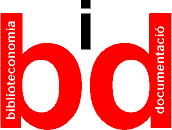The changing face of scholarly communication
[Versió catalana]
David C. Prosser
SPARC Europe
david.prosser@bodley.ox.ac.uk
Scholarly communication should exist for the benefit of the world's research and teaching community. Authors want to share new findings with all their colleagues, while researchers, students,
and other readers want access to all of the relevant literature.
However, the traditional system of scholarly communication is not working. Libraries and their institutions worldwide can no longer keep up with the increasing volume and cost of scholarly resources.
Authors communicate with only those of their peers lucky enough to be at an institution that can afford to purchase or license access to their work. Readers only have access to a fraction of the
relevant literature, potentially missing vital papers in their fields.
The promise of the digital revolution to shrink costs and expand access has been threatened by those publishers that have sought to maximize revenues by raising prices and restricting use. But
efforts to counter this trend –employing new technologies and business models to provide wider access at lower societal cost– are underway and gaining momentum.
Involvement by the library and academic communities is critical in ensuring that these efforts succeed. Together we can develop a new system that meets the needs of librarians, researchers as authors
and readers, students, and society as a whole.
The system is no longer working
Readers are finding it harder and harder to get access to the full-text of articles they need as most campuses continue to cancel journal subscriptions. Worldwide journal prices continue to rise
significantly faster than inflation and library budgets. In North America, for example, research libraries spent 227% more on journals in 2002 than in 1986. In the UK, journal prices rose 158%
between 1991 and 2001 compared to a 28% increase in inflation.
These increases have led to continued journal cancellations, with fewer journals being purchased by libraries. However, despite cuts in subscriptions, some publishers continue to post large profits
–up to 40% in some cases– while expanding their market control through acquisitions, mergers, and the purchase of individual titles from learned and professional societies. Mergers
typically result in significant increases in subscription prices.
While a growing number of journals are now available online, this access often comes at an extra cost, further stretching library budgets. Many colleges and universities cannot provide this access
for their researchers and students.
Although electronic publishing is a promising avenue for scholarly research, it brings its own challenges
Some major publishers seek to restrict access to electronic information through legislation and technical protection systems and many of the electronic resources available are governed by licenses
that restrict how researchers and students can use the content.
Some publishers have bundled all their electronic journals to provide additional access, but licenses for these packages tie up significant portions of library budgets. This can divert funds from
subscriptions to high-quality titles from smaller publishers.
The system is changing
There is growing momentum for change in the way that we handle scholarly communications and the library and academic community is leading the efforts to create change. In particular:
- Increasing numbers of libraries are taking on role of hosts for institutional repositories, maintaining electronic archives of the intellectual wealth of their institutions (http://www.arl.org/sparc/IR/ir.html).
- Increasing numbers of high-quality, peer reviewed journals are being published that make no charge to readers for access, so increasing the dissemination and impact of the research published in
them (see http://www.doaj.org).
- These ‘open access' journals are attracting high quality authors, readers, and editors who realize the benefits of open access.
- Traditional publishers (such as Oxford University Press) are attempting to transform their subscription-based journals into open access.
- There is increasing awareness amongst authors of the need to retain their publishing rights, so that they can reuse their own work in ways that are useful to them. Authors are using the Project
RoMEO listing of publishers' attitudes to authors rights to help them decide where to publish (http://www.lboro.ac.uk/departments/dis/disresearch/romeo/index.html).
- Funding bodies are becoming increasingly aware of their responsibilities towards the dissemination of research results. Recently, all the German Funding agencies announced their support of open
access in the Berlin Declaration
(http://www.zim.mpg.de/openaccess-berlin/berlindeclaration.html) following a similar statement from the
Wellcome Trust in the UK (http://www.wellcome.ac.uk/en/1/awtvispolpub.html).
Next stages
The library community can continue to help to bring about change in scholarly communication. In particular, librarians can:
- Set up and maintain institutional repositories.
- Help faculty deposit their research papers, new and old, in the repositories.
- Help open access journals launched at their institutions become known to other libraries, indexing services, potential funders, and potential readers.
- Make sure scholars at their institution know how to find open access journals and archives in their fields.
- As open access journals proliferate, and as their usage and impact grow, cancel over-priced journals that do not measure up.
- Engage with university administrators, scholars, funding bodies, etc. to raise the issues.
Conclusions
The Budapest Open Access Initiative, issued on 14th February 2002 stated that “an old tradition and a new technology have converged to make possible an unprecedented public
good.” (http://www.soros.org/openaccess/read.shtml). The “public good” is the opening up of the scholarly
literature to all interested readers – researchers, teachers, students, administrators, funding bodies, and the general public. It will increase the impact of research already carried out and
help to accelerate new discoveries. It will allow those in the developing world to read from a huge body of knowledge that they currently only have only limit access to. This public good is within
our reach and by working together we can attain it.
![]() Comentaris
Comentaris